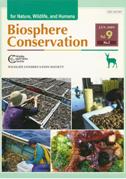Digestibility of food resources in Sika deer habitat were measured using
in vitro methods using rumen inocula of deer and sheep or a cellulolitic enzyme. Experimental samples were collected both in warm temperate (150-900m above sea level) and cool temperate (900-1500m above sea level) zones in the mountainous of Tanzawa. A total of 150 test plants consisted of 39 samples of 38 species in summer and 111 samples of 65 species in winter. The test plants consisted of leaves and stems from forbs and grasses, leaves, dead leaves, twigs, and bark from evergreen or deciduous broadleaved shrubs and trees. Dry matter digestibility (DMD) measured by the two-step method (a series of incubations with rumen inocula and acidic pepsin solution) using rumen inocula of Sika deer ranged from 23.5% for leaf in
Polygonum filiforme to 83.8% of leaf in
Isopyrum stoloniferum in summer and from 0.3% of dead leaf in
Fagus crenata to 76.6% of leaves in Cardamine flexuosa in winter. Compared with these results, DMD measured by the method using sheep rumen inocula was fitted for predicting
in vitro DMD used deer rumen fluid and highly correlated with each pair of the values. DMD assayed by the enzymatic method, combining a series of incubations using the acid-pepsin treatment and cellulolitic digestion, was correlated with the samples collected in winter and in the cool temperate area in summer, but did not fit with the samples from the warm temperate area in summer. Our experimental results showed that
in vitro methods using sheep rumen inocula are useful in predicting
in vitro DMD of deer, and the enzymatic method is also able to measure DMD of food resources in winter deer habitat. The results are also available to evaluate the nutritive quality of plant resources eaten by free-ranging deer.
View full abstract
